
The Hebron massacre refers to the killing of sixty-seven Jews (including 23 college students) on 24 August 1929 in Hebron, then part of Mandatory Palestine, by Arabs incited to violence by false rumors that Jews were massacring Arabs in Jerusalem and seizing control of Muslim holy places.[1] The event also left scores seriously wounded or maimed. Jewish homes were pillaged and synagogues were ransacked. Many of the 435 Jews who survived were hidden by local Arab families.[2][3] Soon after, all Hebron's Jews were evacuated by the British authorities.
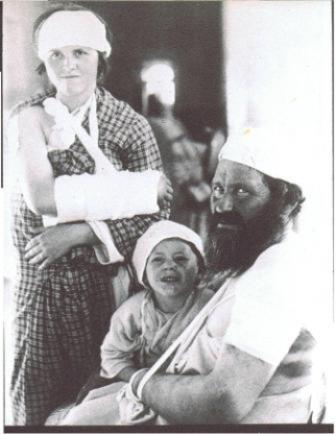
Many returned in 1931, but almost all were evacuated at the outbreak of the 1936–1939 Arab revolt in Palestine. The massacre formed part of the 1929 Palestine riots, in which a total of 133 Jews were killed by Arabs, and brought the centuries-old Jewish presence in Hebron to an end.
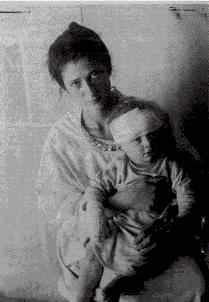
The massacre, together with that of Jews in Safed, sent shock waves through Jewish communities in Palestine and around the world. It led to the re-organization and development of the Jewish paramilitary organization, the Haganah, which later became the nucleus of the Israel Defense Forces.[citation needed] In the metanarrative of Zionism, according to Michelle Campos, the event became 'a central symbol of Jewish persecution at the hands of bloodthirsty Arabs'[4] and was 'engraved in the national psyche of Israeli Jews', particularly those who settled in Hebron after 1967.[5]
Background
Simmering tensions
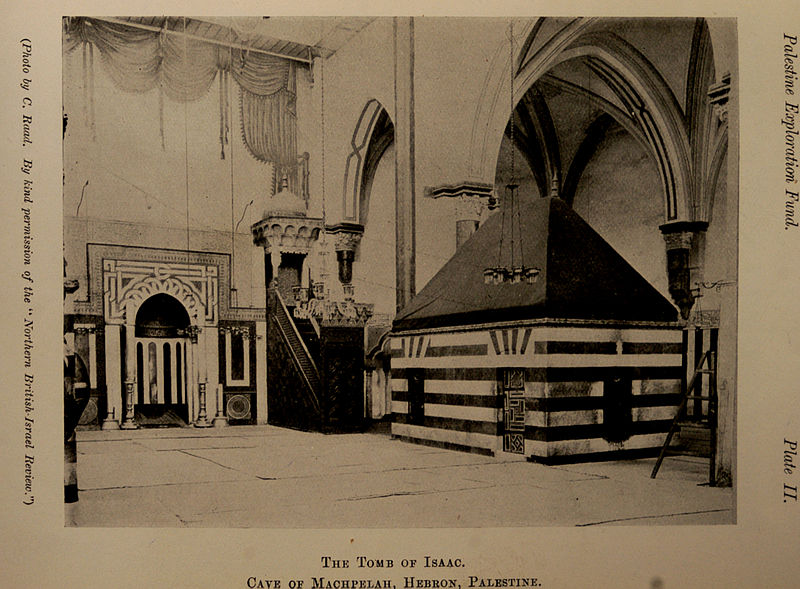
The city of Hebron holds special significance in Islam and Judaism, it being the site of the Tomb of the Patriarchs. In 1929, the population numbered around 20,000, the majority of whom were Muslim Arabs. A small but significant community of around 700 Jews, a number living deep within Hebron but most renting houses from Arab proprietors on the outskirts,[6][7] also lived there. The Jewish community was divided between recent Ashkenazi immigrants and an older population of descendants of Sephardim who had inhabited the town for centuries. Ashkenazi Jews had been established in the town for at least a century.[8]

The two communities, Sephardim and Ashkenazi, maintained separate schools, worshipped in separate synagogues, and did not intermarry. The Sephardim were Arab-speakers, wore Arab-dress and were well-integrated, whereas many of the Ashkenazi community were yeshiva students who maintained 'foreign' ways, and had difficulties and misunderstandings with the Arab population.[9] Since the Balfour Declaration of 1917, tensions had been growing between the Arab and Jewish communities in Palestine.[10] The Muslim community of Hebron had a reputation for being highly conservative in religion. Though Jews had suffered numerous vexations in the past, and this hostility was to take an anti-Zionist turn after the Balfour Declaration.[11] generally, a peaceful relationship existed between both communities.[12]


In mid-August 1929, hundreds of Jewish nationalists marched to the Western Wall in Jerusalem shouting slogans such as The Wall is Ours and raising the Jewish national flag.[8] Rumours spread that Jewish youths had also attacked Arabs and had cursed Muhammad.[13][14] Following an inflammatory sermon the next day, hundreds of Muslims converged on the Western Wall, burning prayer books and injuring the beadle. The rioting soon spread to the Jewish commercial area of town[15][16] and the next day, a young Jew was stabbed to death.[17] The authorities failed to quell the violence. On Friday, August 23, inflamed by rumors that Jews were planning to attack al-Aqsa Mosque, Arabs started to attack Jews in the Old City of Jerusalem.

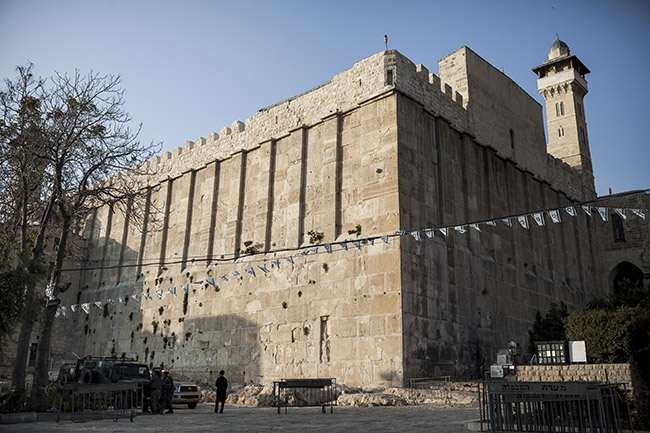
The first murders of the day took place when two or three Arabs passing by the Jewish Quarter of Mea Shearim were assassinated.[18] Rumours that Jews had massacred Arabs in Jerusalem arrived in Hebron by that evening.[6]
Haganah offers protection
Former Haganah member, Baruch Katinke, recalled that he had been informed by his superiors that 10-12 fighters were needed to protect the Jews in Hebron. On August 20, a group travelled to Hebron in the middle of the night and met with a Jewish community leader, Eliezer Dan Slonim. Katinke said that Slonim was adamant that no protection was needed as he was on good terms with the local Arabs and he trusted the a'yan (Arab notables) to protect the Jews. According to Katinke, Slonim postulated that the sight of the Haganah might instead cause a provocation. The group was soon discovered and Police Superintendent Raymond Cafferata ordered them to return to Jerusalem. Two others remained in Slonim's house, but the day after, they too returned to Jerusalem as requested by Slonim.[19]Hebron police force

Prelude
On Friday afternoon August 23, after hearing reports of rioting in Jerusalem, a crowd of 700 Arabs gathered at the city's central bus station intending to travel to Jerusalem. Cafferata attempted to placate them, and as a precaution, asked the British authorities to send reinforcements to Hebron.[8] He then arranged for a mounted patrol to be sent to the Jewish quarter, where he encountered Rabbi Yaakov Yosef Slonim-Dwek who asked for police protection after Jews had been attacked with stones. Cafferata instructed the Jews to stay in their homes, while he tried to disperse the crowds.[8] Jewish newspaper accounts carried various claims by survivors that they had heard Arab threats to "divvy up [Jewish] women", that Arab homeowners had told their Jewish neighbours "today will be the great slaughter," and that several of the victims took tea with so-called friends who, in the afternoon, became their killers.[21]
At around 4:00 pm, stones were thrown through the windows of Jewish homes. The Hebron Yeshiva was hit and as a student tried to escape the building, he was set upon by the mob who stabbed him to death. The sexton, the only other person in the building at the time, survived by hiding in a well. Some hours later Cafferata attempted to get the local mukhtars to assume responsibility for law and order, but they told him that the Mufti had told them to take action or be fined due to the 'Jewish slaughter of Arabs' in Jerusalem. Cafferata told them to return to their villages, but expecting some disturbances, he slept in his office that night.[8]

The attack
The rampage and the killing

At about 8.30 am Saturday morning, the first attacks began to be launched against houses were Jews resided,[6] after a crowd of Arabs armed with staves, axes and knives appeared in the streets. The first location to be attacked was a large Jewish house on the main road. Two young boys were immediately killed, whereupon the mob entered the house and beat or stabbed the other occupants to death.

Cafferata appeared on the scene, gave orders to his constables to fire on the crowd and personally shot dead two of the attacking Arabs.[6] While some dispersed, the rest managed to break through the pickets, shouting "on to the ghetto!" Requested reinforcements had not arrived in time. This later became the source of considerable acrimony.[8]
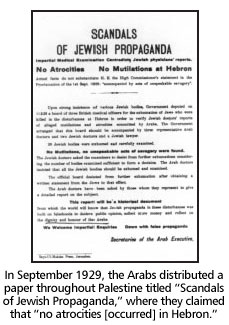
According to a survivor, Aharon Reuven Bernzweig, "right after eight o'clock in the morning we heard screams. Arabs had begun breaking into Jewish homes. The screams pierced the heart of the heavens. We didn't know what to do… They were going from door to door, slaughtering everyone who was inside. The screams and the moans were terrible. People were crying Help! Help! But what could we do?"

Soon after news of the first victim had spread, forty people assembled in the house of Eliezer Dan Slonim. Slonim, the son of the Rabbi of Hebron, was a member on the city council and a director of the Anglo-Palestine Bank. He had excellent relations with the British and the Arabs and those seeking refuge with him were confident they would come to no harm. When the mob approached his door, they offered to spare the Sephardi community if he would hand over all the Ashkenazi yeshiva students. He refused, saying "we are all one people," whereupon he was shot dead along with his wife and 4-year-old son.[22] From the contemporary Hebrew press it appears that the rioters targeted the Zionist community for their massacre. Four-fifths of the victims were Ashkenazi Jews, though some had deep roots in the town, yet a dozen Jews of eastern origin, Sephardim and Maghrebi, were also killed.[21] Ben-Zion Gershon, for example, the Beit Hadassah Clinic pharmacist, a cripple who had served both Jews and Arabs for 4 decades, was killed together with his family: his daughter was raped and then murdered, and his wife's hands were cut off.[8]
Account of Raymond Cafferata

After the masacre, Cafferata testified:
"On hearing screams in a room, I went up a sort of tunnel passage and saw an Arab in the act of cutting off a child's head with a sword. He had already hit him and was having another cut, but on seeing me he tried to aim the stroke at me, but missed; he was practically on the muzzle of my rifle. I shot him low in the groin. Behind him was a Jewish woman smothered in blood with a man I recognized as a[n Arab] police constable named Issa Sheriff from Jaffa. He was standing over the woman with a dagger in his hand. He saw me and bolted into a room close by and tried to shut me out-shouting in Arabic, "Your Honor, I am a policeman." ... I got into the room and shot him."[8][23][24]
Account of Jacob Joseph Slonim
Rabbi Jacob Joseph Slonim, the Ashkenazi chief rabbi of Hebron, stated that after his Arab acquaintances had informed him that local hooligans intended to attack the talmudical academy, he had gone to ask for protection from District Officer Abdullah Kardus, but was denied an audience with him. Later on after being attacked in the street, he had approached the chief of police, but Cafferata refused to take any measures, telling him that "the Jews deserve it, you are the cause of all troubles." The next morning, Slonim again urged the District Officer to take preventative measures, but he was told there was "no ground for fear. A great number of police is available. Go and reassure the Jewish population." Two hours later, a mob incited by speeches started breaking into Jewish homes with cries of "Kill the Jews." The massacre lasted an hour and a half, and only after it had died down, did the police take action, firing shots into the air, whereupon the crowds immediately dispersed. Sloinm himself was saved by a friendly Arab.[25] Of the 67 victims of the massacre, 12 were women and 3 were children under the age of 5.[6]Looting, destruction and desecration
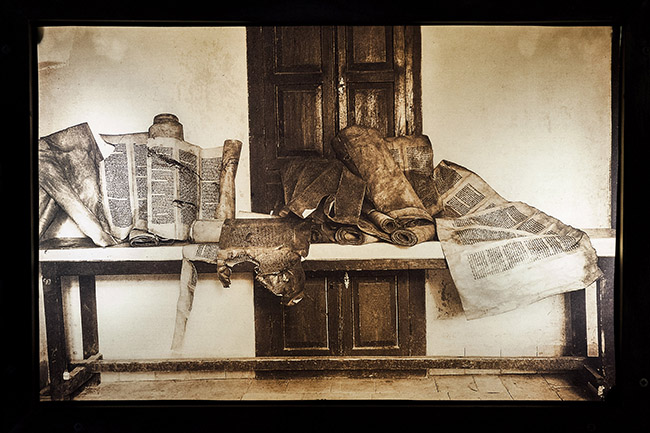
The attack was accompanied by wanton destruction and looting. A Jewish hospital, which had provided treatment for Arabs, was attacked and ransacked. Numerous Jewish synagogues were vandalised and desecrated.[26] According to one account, Torah scrolls in casings of silver and gold were looted from the synagogues and manuscripts of great antiquity were pilfered from the library of Rabbi Judah Bibas.[27] The library, founded in 1852, was partly burned and destroyed.[28] In one instance, a rabbi who had saved a Torah scroll from a blazing synagogue, later died from his burns.[29]
Arabs shelter Jews
Around 25 Arab families helped save 280-300 Jews by sheltering them during the melee.[2]Aharon Reuven Bernzweig related that an Arab named Haj Eissa El Kourdieh, saved a group of 33 Jews after he insisted they hide in his cellar. There they waited with a "deadly fear" for the trouble to pass, worrying that the "murderers outside would hear [the little children who kept crying]." From the cellar, they heard cries of "today is a day that is holy to Mohammed. Anyone who does not kill Jews is a sinner." Meanwhile, several Arab women, stood guard outside, repetitively challenging the claims of the screaming mob that they were sheltering Jews.[2] Yonah Molchadsky gave birth while taking refuge in an Arab basement. Molchadsky later related that when the mob demanded that Arabs give up any Jews they were hiding, her host told them "we have already killed our Jews," whereupon the mob departed.[30] The family of Abu Id Zaitoun rescued Zmira Mani and other Jews by hiding them in their cellar and protecting them with their swords. They later found policeman to escort them safely to the police station at Beit Romano.[31]
Survivors

Around 435 Jews survived, most having been saved by a handful of Arab families. Around 130 saved themselves by hiding or by taking refuge in the British police station at Beit Romano on the outskirts of the city.[2] After order had been restored, all the Jews were gathered at the police station where hundreds of people were confined for three days, without food or water. They were also forbidden from making telephone calls. All the survivors were then evacuated to Jerusalem.
Aftermath
Numbers killed and injured

In total, 67 Jews and 9 Arabs were killed.[32] Of the Jews killed, 59 died during the rioting and 8 more later succumbed to their wounds. They included a dozen women and three children under the age of three. Twenty-four of the victims were students from the Hebron yeshiva, seven of whom were American or Canadian. The bodies of 57 Jewish victims were buried in mass graves by Arabs, without regard to Jewish burial ritual. Most of the murdered Jews were of Ashkenazi descent, while 12 were Sephardi. 58 are thought to have been injured, including many women and children. One estimate put the figure at 49 seriously and 17 slightly wounded.[2] A letter from the Jews of Hebron to the High Commissioner described cases of torture, mutilation and rape.[33] Eighteen days after the massacre, the Jewish leadership requested that bodies be exhumed to ascertain whether deliberate mutilation had taken place.[34] But after 20 bodies had been disinterred and reburied, it was decided to discontinue. The bodies had been exposed for two days before burial and it was almost impossible to ascertain whether or not they had been subject to mutilations after or during the massacre.[35] No conclusions could therefore be made.[36]
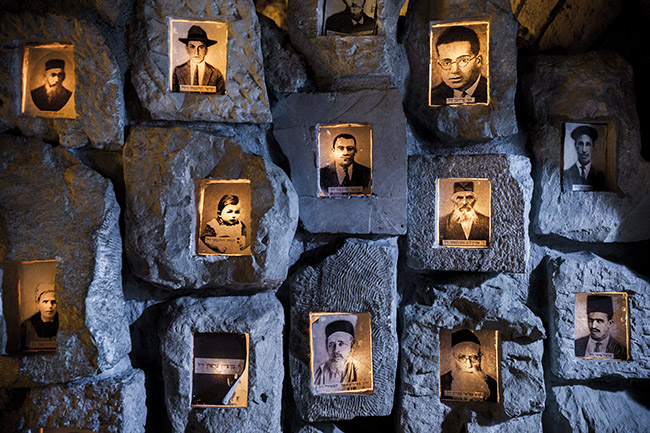
Reaction and response
Commission of Enquiry

The Shaw Commission was a British enquiry that investigated the violent rioting in Palestine in late August 1929. It described the massacre at Hebron:
"About 9 o'clock on the morning of the 24th of August, Arabs in Hebron made a most ferocious attack on the Jewish ghetto and on isolated Jewish houses lying outside the crowded quarters of the town. More than 60 Jews – including many women and children – were murdered and more than 50 were wounded. This savage attack, of which no condemnation could be too severe, was accompanied by wanton destruction and looting. Jewish synagogues were desecrated, a Jewish hospital, which had provided treatment for Arabs, was attacked and ransacked, and only the exceptional personal courage displayed by Mr. Cafferata – the one British Police Officer in the town – prevented the outbreak from developing into a general massacre of the Jews in Hebron."[26]

Cafferata testified to the Commission of Enquiry in Jerusalem on 7 November. The Times reported Cafferata's evidence to the Commission that "until the arrival of British police it was impossible to do more than keep the living Jews in the hospital safe and the streets clear [because he] was the only British officer or man in Hebron, a town of 20,000".[37]
On September 1, Sir John Chancellor condemned:-
'the atrocious acts committed by bodies of ruthless and bloodthirsty evildoers... murders perpetrated upon defenceless members of the Jewish population... accompanied by acts of unspeakable savagery.'
Trials and convictions
One of the chief instigators of the massacre, Sheik Taleb Markah, denied the allegations against him and claimed he endeavoured to pacify the mob.[38] He was sentenced to two years imprisonment.[39] Two of the four Arabs charged with the murder of 24 Jews in the house of Rabbi Jacob Slonim were sentenced to death.[40]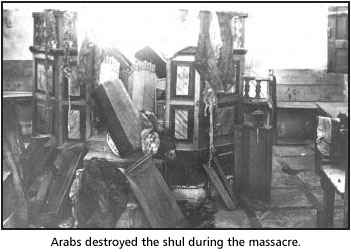
In Palestine overall, 195 Arabs and 34 Jews were sentenced by the courts for crimes related to the 1929 riots. Death sentences were handed down to 17 Arabs and two Jews, but these were later commuted to long prison terms except in the case of three Arabs who were hanged.[41] Large fines were imposed on 22 Arab villages or urban neighborhoods.[41] The fine imposed on Hebron was 14,000 pounds.[42] Financial compensation totaling about 200,000 pounds was paid to persons who lost family members or property.[41]
Decline of Jewish community

Some Hebron Arabs, amongst whom the President of Hebron's Chamber of Commerce, Ahmad Rashid al-Hirbawi, favoured the return of Jews to the town.[43] The returning Jews quarrelled with the Jewish Agency over funding. The Agency did not agree to the idea of reconstituting a mixed community, but rather pressed for the establishment of a Jewish fortress wholly distinct from the Arab quarters of Hebron.[44] In the spring of 1931, 160 Jews returned together with Rabbi Chaim Bagaio. During the disturbances of 1936 they all left the town for good, except for one family, that of Yaakov Ben Shalomn Ezra, an eighth generation Hebronite who was a dairyman, who eventually left in 1947, on the eve of the 1948 Palestine War.[45]
Yeshiva relocates to Jerusalem
After the massacre, the remainder of the Hebron yeshiva relocated to Jerusalem.[8]
Jewish re-settlement after 1967
During the 1967 Six-Day War, Israel gained Hebron from Jordan. Residents, terrified that Israeli soldiers might massacre them in retaliation for the events of 1929, waved white flags from their homes and voluntarily turned in their weapons.[46] Subsequently, Israelis settled in Hebron as part of Israel's settlement program, and the Committee of The Jewish Community of Hebron was established. Today, hundreds of Israelis live in Hebron, and thousands live in Kiryat Arba, an Israeli settlement established on the city's outskirts.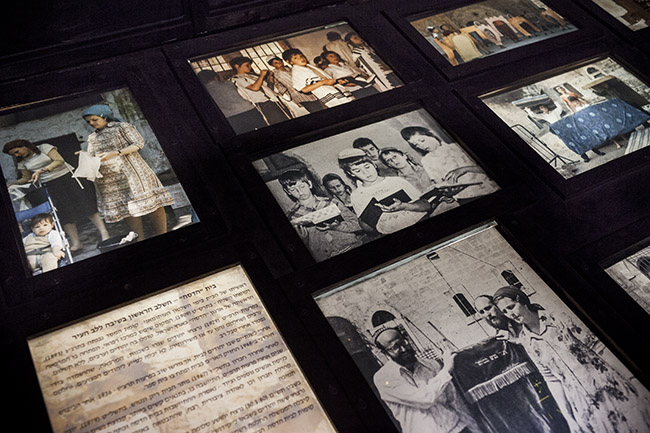
Descendants of the survivors are divided, with some claiming they wish to return, but only when Arab and Jewish residents can find a way to live together peacefully. Other survivors and descendants of survivors support the new Jewish community in Hebron.[47]
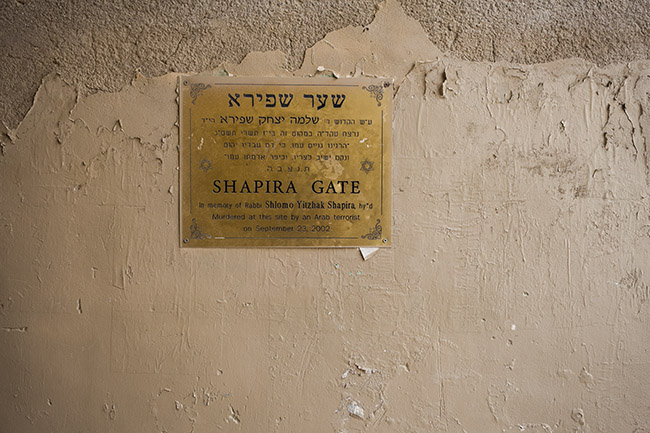
1999 documentary film
Noit Gevas, daughter of a survivor, discovered that her grandmother, Zemira Mani (who was the granddaughter of Hebron's chief Sephardic rabbi, Eliyahu Mani), had written an account of the massacre, published in the Haaretz newspaper in 1929. In 1999 Gevas released a film containing testimonies of 13 survivors that she and her husband Dan had managed to track down from the list in "Sefer Hebron" ("The Book of Hebron"). Originally intended to document the story of the Arab who had saved Gevas's mother from other Arabs, it became also an account of the atrocities of the massacre itself. These survivors (most of whom no longer live in Israel) are mixed as to whether they can forgive.
In the film, "What I Saw in Hebron"[48] the survivors – now very elderly – describe pre-massacre Hebron as a kind of paradise surrounded by vineyards, where Sephardic Jews and Arabs lived in idyllic coexistence. The well-established Ashkenazi residents were also treated well – but the Arabs' anger was roused by followers of the Jerusalem Mufti as well as local chapters of the (Arab) Muslim-Christian Societies.
According to Asher Meshorer (Zemira Mani's son and Noit Geva's father), his aunt (Zemira Mani's sister - who was not present in Hebron during the massacre) had told him that the Arabs from the villages essentially wanted to kill only the new Ashkenazim. According to her, there was an alienated Jewish community that wore streimels, unlike the Sephardi community, which was deeply rooted, speaking Arabic and dressing like Arab residents.

When the riots started, representatives of the Arabs came to the chief Hebron Rabbi, Rabbi Slonim Dwek, with a proposal – if he allowed them to kill 70 students from the yeshiva in Hebron, they would not kill the other Ashkenazim or the Sephardim. Rabbi Slonim Dwek told them, "We Jews are all one people." He was the first person to be killed in the riots, as he held his eldest son, 4 years old in his hands, who was also killed.[49]

The Mani family was saved by an Arab neighbour, Abu 'Id Zeitun, who was accompanied by his brother and son. Nowadays (in 1999), according to Abu 'Id Zeitun, the house in which the Jews were hidden – his father's house – had been confiscated by the IDF, and today it houses a kindergarten for the settlers.[citation needed]

Taken from: http://en.wikipedia.org/wiki/1929_Hebron_massacre [23.08.2013]
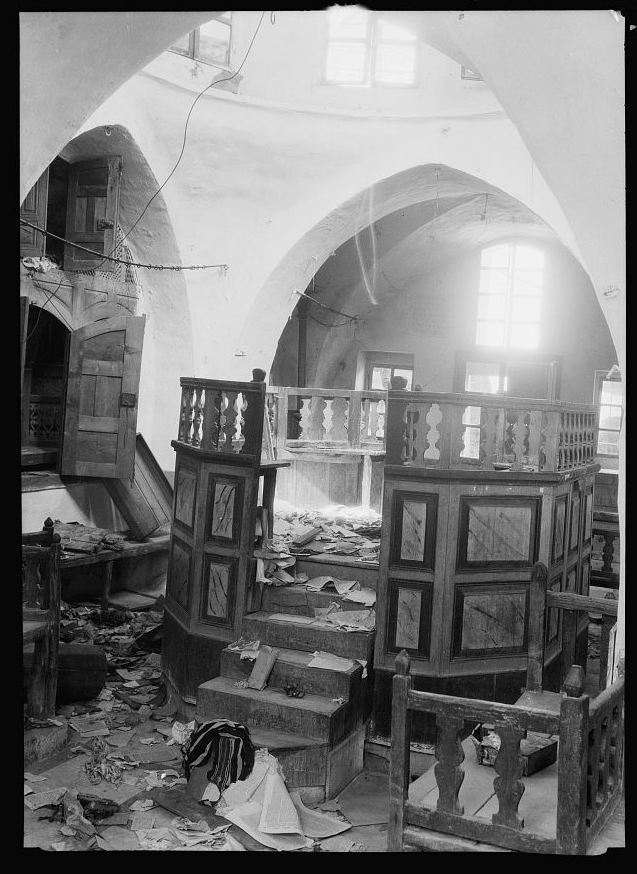
References
3.
^ Independent 26 January 2008 A rough guide to
Hebron: The world's strangest guided tour highlights the abuse of Palestinians
4.
^ Michelle Campos, 'Remembering Jewish-Arab Contact
and Conflict,' in Sandra Marlene Sufian, Mark LeVine, (eds.) Reapproaching
Borders: New Perspectives on the Study of Israel-Palestine, Rowman &
Littlefield 2007 p. 41 of pp. 41-65.
5.
^ Matthew Levitt Negotiating Under Fire:
Preserving Peace Talks in the Face of Terror Attacks, Rowman &
LIttlefield, 2008 p. 28
7.
^ Segev, Tom (2000) p. 318...A few dozen Jews
lived deep within Hebron, in a kind of ghetto where there were also several
synagogues. But the majority lived on the outskirts, along the roads to
Be'ersheba and Jerusalem, renting homes owned by Arabs, a number of which were
built for the express purpose of housing Jewish tenants.
8.
^ a b c d e f g h i Segev, Tom (2000). One Palestine, Complete.
Metropolitan Books. pp. 314–327. ISBN 0-8050-4848-0.
9.
^ Michelle Campos, 'Remembering Jewish-Arab Contact
and Conflict,' in Sandra Marlene Sufian, Mark LeVine, (eds.) Reapproaching
Borders: New Perspectives on the Study of Israel-Palestine, Rowman &
Littlefield 2007 pp.41-65 pp.55-56.
12. ^ 'Hebron had, until this time, been outwardly
peaceful, although tension hid below the surface. The Sephardi Jewish community
in Hebron had lived quietly with its Arab neighbors for centuries.' Shira
Schoenberg ‘The Hebron Massacre of 1929,’ Jewish Virtual Library
15. ^ Report of the Commission on the Palestine
Disturbances of August 1929, Command paper Cmd. 3530
16. ^ Gilbert, Martin (1977). "Jerusalem, Zionism
and the Arab Revolt 1920-1940". Jerusalem Illustrated History Atlas.
London: Board of
Deputies of British Jews. p. 79. ISBN 0-905648-04-8.
17. ^ J.Bowyer Bell, Terror out of Zion: The Fight for Israeli Independence,
Transaction ed.Prologue p.1 name
19. ^ Baruch Katinke (1961). מאז ועד הנה [From then until now]
(in Hebrew). קרית ספר. p. 271. Retrieved 1 June 2011. and testimony in the Haganah archives
21. ^ a b Michelle Campos, 'Remembering
Jewish-Arab Contact and Conflict,' in Sandra Marlene Sufian, Mark LeVine,
(eds.) Reapproaching Borders: New Perspectives on the Study of
Israel-Palestine, Rowman & Littlefield 2007 pp.41-65, pp55-56
24. ^ It should be noted that some survivors testified
that more than one of the Hebronite Arab policemen joined the riot.[citation needed]
26. ^ a b "Commission on the Palestine
Disturbances of August 1929 (The Shaw Commission)". March 1930.
p. 64.
30. ^ Haaretz. Survivor of 1929 Hebron Massacre recounts her ordeal by Eli
Ashkenazi. Last accessed: 12 August 2009/
31. ^ Zmira Mani (later renamed Zmira Meshorer),
"What I saw in Hebron" ("ma shera'iti beħevron"), Haaretz,
Sep 12, 1929, reprinted in: Knaz, Yehoshua (ed.) (1996).Haaretz - the 75th
Year, Schocken Publishing, Jerusalem and Tel Aviv, pp. 33–34 (in Hebrew).
36. ^ Tom Segev (2000) p. 330. The Department of Health
report to the Shaw Commission
said: "A complete post mortem record of the cause of death in the case of
the killed was not obtainable at the time, in view of the large number of
wounded that had to be dealt with by the limited medical staff. As a result of
external inspection by the Senior Medical Officer and British Police Officer no
mutilation of bodies was observed. A subsequent exhumation demanded by the
Jewish authorities with the object of proving or disproving deliberate
mutilation took place on September 11th. Twenty bodies were exhumed and
examined by a specially appointed Committee consisting of the Government Pathologist,
Dr. G. Stuart, and two non-official British doctors, Dr. Orr Ewing and Dr.
Strathearn. The representatives of the Jewish authorities asked that the
remaining bodies not be exhumed. The alleged mutilation of bodies was not
confirmed by the Committee." Minutes of Evidence, Exhibit 17 (page
1031).
37. ^ 'The Hebron Tragedy. Mr. Cafferata's Evidence',
From Our Correspondent. The Times, Friday, November 8, 1929; pg. 13;
Issue 45355; col D.
41. ^ a b c Report by his Majesty's
Government...to the Council of the League of Nations on the Administration of
Palestine and Trans-Jordan for the year 1930. Sections 9–13.
43. ^ The New Republic. 'The Tangled Truth', by
Benny Morris, May 07, 2008, book review of Hillel Cohen's (2008) Army of
Shadows: Palestinian Collaboration with Zionism, 1917-1948 Translated by Haim
Watzman University of California Press, ISBN 0-520-25221-7
44. ^ Michelle Campos, 'Remembering Jewish-Arab Contact
and Conflict,' in Sandra Marlene Sufian, Mark LeVine, (eds.) Reapproaching
Borders: New Perspectives on the Study of Israel-Palestine, Rowman &
Littlefield 2007 pp. 41-65 p. 56.
48. ^ "What I Saw in Hebron", The National
Center for Jewish Film, Israel, 1999, 73 min, color, Hebrew & Arabic w/
English subtitles. Verified 27 Apr 2008.
49. ^ Hebron Diary, daughter of a survivor tells story
of film "Things I saw in Hebron". Verified 27 Apr. 2008.

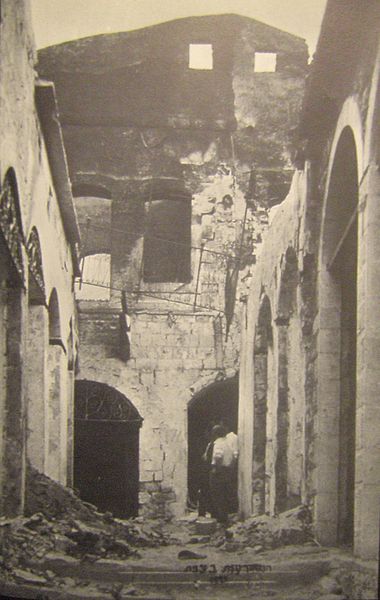
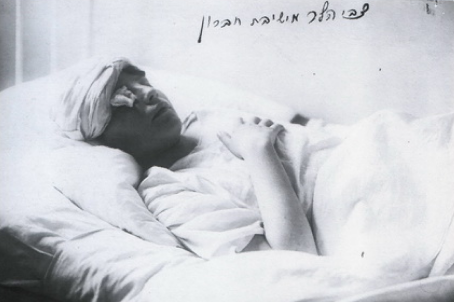



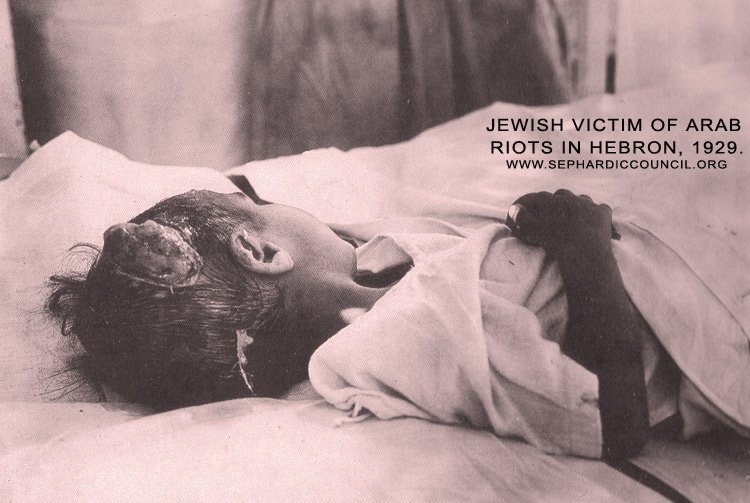




No comments:
Post a Comment